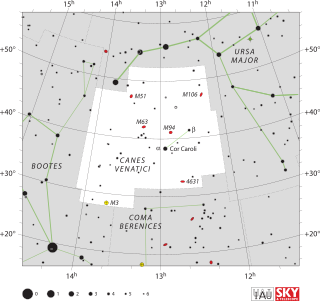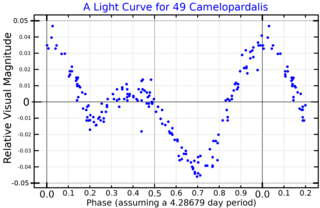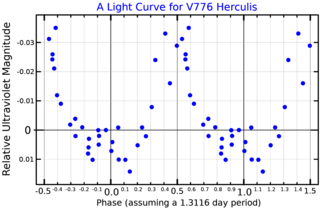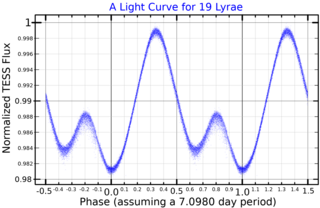
Cor Caroli is a binary star designated Alpha Canum Venaticorum or α Canum Venaticorum. The International Astronomical Union uses the name "Cor Caroli" specifically for the brighter star of the binary. Alpha Canum Venaticorum is the brightest point of light in the northern constellation of Canes Venatici.

Chi Serpentis is a solitary star in the Serpens Caput section of the equatorial constellation Serpens. Based upon an annual parallax shift of 14.84 mas as seen from Earth, it is located around 222 light years from the Sun. The star is bright enough to be faintly visible to the naked eye, having an apparent visual magnitude of +5.30.

63 Andromedae is an Alpha2 Canum Venaticorum variable star in the constellation Andromeda. Its variable star designation is PZ Andromedae. With an apparent magnitude of about 5.6, it is bright enough to be seen by naked eye. Based upon an annual parallax shift of 8.53 mas, it is located 382 light years away.

13 Andromedae, abbreviated 13 And, is a single, blue-white hued variable star in the northern constellation of Andromeda. 13 Andromedae is the Flamsteed designation, while it bears the variable star designation V388 Andromedae. With a typical apparent visual magnitude of around 5.75, it is dimly visible to the naked eye under good seeing conditions. The distance to this star can be directly estimated from its annual parallax shift of 10.9 mas, yielding a range of 300 light years. At that distance, its brightness is diminished by an extinction of 0.13 magnitude due to interstellar dust. The star is moving closer to the Earth with a heliocentric radial velocity of −8 km/s.

36 Aurigae is a single variable star located about 910 light years away from the Sun in the constellation Auriga. It has the variable star designation V444 Aurigae, while 36 Aurigae is the Flamsteed designation. This object is visible to the naked eye as a dim, white-hued star with a baseline apparent visual magnitude of 5.71. It is moving further from the Earth with a heliocentric radial velocity of +16 km/s.

53 Camelopardalis is a binary star system in the northern circumpolar constellation of Camelopardalis, located 290 light years away from the Sun as determined by parallax measurements. It has the variable star designation AX Camelopardalis; 53 Camelopardalis is the Flamsteed designation. This object is dimly visible to the naked eye as a white hued star with a baseline apparent visual magnitude of +6.02. It is a single-lined spectroscopic binary system with an orbital period of 6.63 years and a high eccentricity of 0.718. The "a sin i" value of the primary is 280 Gm (1.9 AU), where a is the semimajor axis and i is the orbital inclination.

49 Camelopardalis is a variable star in the northern circumpolar constellation of Camelopardalis, located 313 light years from the Sun based on parallax measurements. It has the variable star designation BC Camelopardalis; 49 Camelopardalis is the Flamsteed designation. This star is a challenge to view with the naked eye, having a baseline apparent visual magnitude of 6.50. It is moving away from the Earth with a heliocentric radial velocity of +6.5 km/s.
21 Canum Venaticorum is a single variable star in the northern constellation of Canes Venatici, located 277 light years away from the Sun. This object has the variable star designation BK Canum Venaticorum; 21 Canum Venaticorum is the Flamsteed designation. It is visible to the naked eye as a faint white-hued star with a baseline apparent visual magnitude of +5.14.

KK Andromedae, also known as HD 9531, is a variable star in the northern constellation of Andromeda. It has an apparent visual magnitude of 5.90, which places it near the lower limit of visibility to the naked eye even under good viewing conditions. An Alpha2 Canum Venaticorum variable, it varies in brightness by 0.012 magnitude every 0.66 days. Based upon an annual parallax shift of 7.5 mas as seen from Earth, it is located around 437 light years from the Sun. At that distance, the brightness of the star is diminished by an extinction of 0.26 magnitude due to interstellar dust.

HD 4778, also known as HR 234 and GO Andromedae, is a variable star in the constellation Andromeda. Its magnitude varies by 0.04 magnitudes from the median of 6.12 with a period of approximately 2.55 days. The star is located 350 light years away, as determined from its annual parallax shift of 9.32 mas.
HD 224801, also known as CG Andromedae, is an Alpha2 Canum Venaticorum variable star in the constellation Andromeda. Located approximately 188 parsecs (610 ly) away, the star varies between apparent magnitudes 6.32 and 6.42 over a period of approximately 3.74 days.

ET Andromedae is a binary star system star in the northern constellation of Andromeda. It has an apparent visual magnitude of 6.48, placing it at the nominal limit for visibility with the naked eye. The distance to this system can be estimated from its annual parallax shift of 5.42 mas, which yields a value of 602 light years.
VZ Arietis is single, white-hued star in the northern zodiac constellation of Aries. Varying between magnitudes 5.82 and 5.89, the star can be seen with the naked eye in dark, unpolluted areas. Based upon an annual parallax shift of 5.8 mas, it is located 560 light years from the Sun. It is moving further away with a heliocentric radial velocity of +14 km/s. The star was formerly known as 16 Trianguli, but as the star is no longer in the constellation Triangulum, this designation has fallen out of use.

IQ Aurigae is a single, variable star in the northern constellation of Auriga. It is visible to the naked eye as a dim, white-hued star with an apparent visual magnitude that fluctuates around 5.38. The star is located at a distance of about 460 light-years from the Sun based on parallax and is drifting further away with a radial velocity of +28.6 km/s.

45 Herculis is a solitary variable star in the northern constellation Hercules. It has the Bayer designation l Herculis and the variable star designation V776 Herculis. The Flamsteed designation for this star comes from the publication Historia Coelestis Britannica by John Flamsteed. It is the 45th star in Flamsteed list of stars in the constellation Hercules, and is visible to the naked eye with a baseline apparent visual magnitude of 5.22. Parallax measurements show this star to be about 400 light-years away from the Solar System. It is moving closer to the Earth with a heliocentric radial velocity of −16 km/s.
4 Cygni is a binary star system in the northern constellation of Cygnus. It is a faintly visible to the naked eye with an apparent visual magnitude of 5.17. The distance to 4 Cygni, as determined from its annual parallax shift of 5.8 mas, is about 560 light years.

GR Andromedae is a variable star in the constellation Andromeda. Its apparent visual magnitude varies between 6.87 and 6.95 in a cycle of 518.2 days. It is classified as an α2 Canum Venaticorum variable.

HN Andromedae is a variable star in the constellation Andromeda. Its apparent visual magnitude varies between 6.67 and 6.76 in a cycle of 69.51 days. It is classified as an α2 Canum Venaticorum variable.

19 Lyrae is a single variable star located approximately 950 light years away from the Sun in the northern constellation of Lyra. It has the variable star designation V471 Lyr, while 19 Lyrae is the Flamsteed designation. This object is just bright enough to be visible to the naked eye, appearing as a dim, blue-white star with a baseline apparent visual magnitude of 5.93. It is moving closer to the Earth with a heliocentric radial velocity of −30 km/s, and may come as close as 167 light-years around 8.5 million years from now.

HD 125248 is a binary star system in the equatorial constellation of Virgo. It has the variable star designation CS Virginis, while HD 125248 is the designation from the Henry Draper Catalogue. This system is dimly visible to the naked eye as a point of light with an apparent visual magnitude that ranges from 5.84 down to 5.95. It is located at a distance of approximately 280 light years from the Sun based on parallax measurements, but is drifting closer with a heliocentric radial velocity of −8 km/s.
















